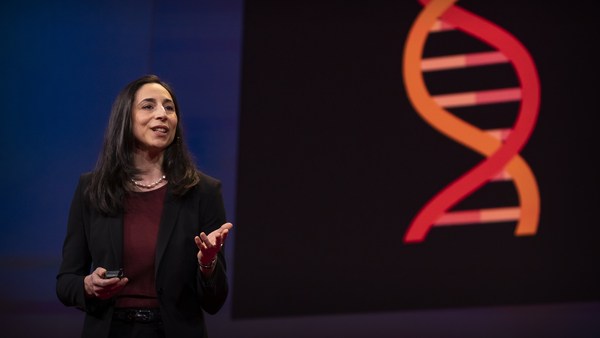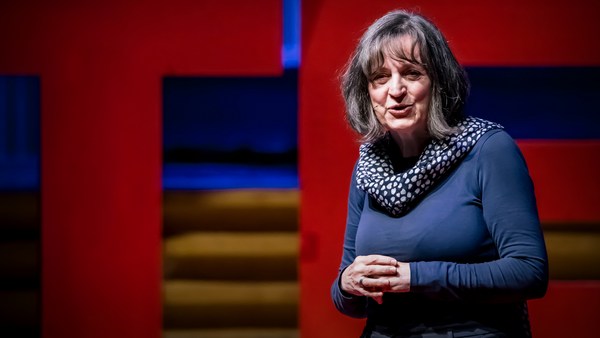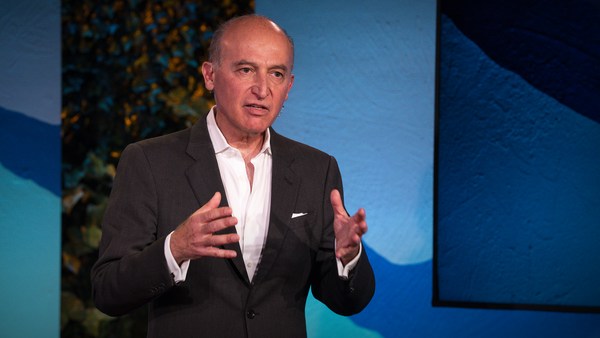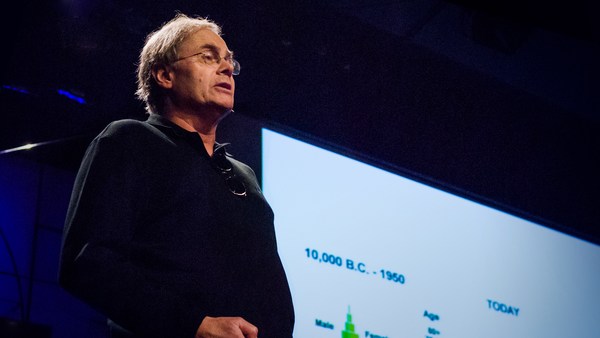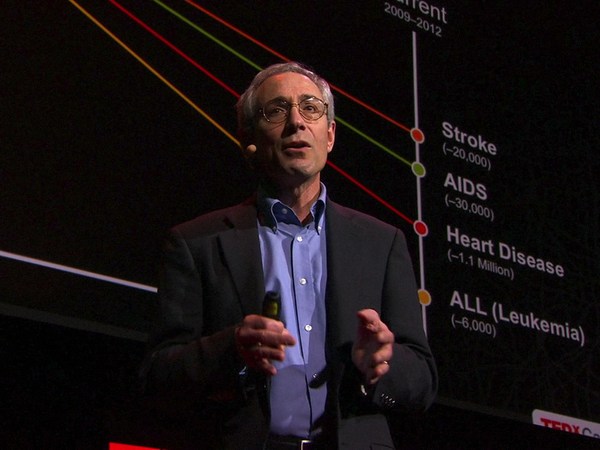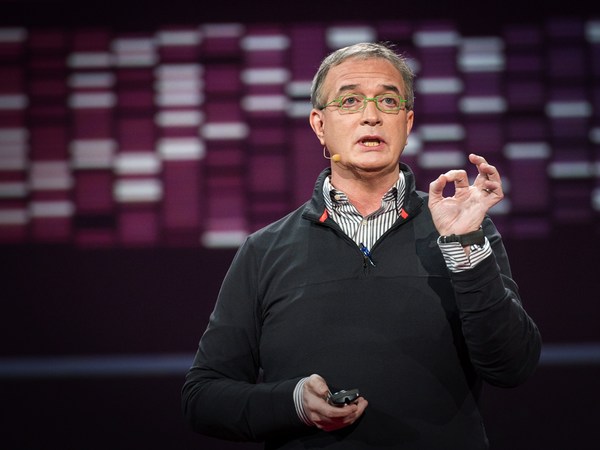I'm here because of a letter I got 13 years ago. A letter from the future. This is it. It's a predictive genetic test report. And it's at the heart of this sort of red pill-blue pill moment when my life forked in two.
Before I tell you about that, I want to show you two moments from my life back then. This is moment number one. It's August 2009. I’m marrying this guy, Eric, love of my life. And he gets up there to give his speech and he's holding my diary from when I was 13. And he starts reading from it, and the guests are looking at me like, "Did she know he was going to do this?" Guys, if you're watching, I knew. OK, this is me and my mom. You can see how she’s laughing but she’s kind of scandalized.
(Laughter)
She’s 51 years old and on this day, she is glowing. I wish I could stay here with you. But now I have to take you to moment number two.
It's only six months later, and suddenly there's this tear in the universe, and my mom is being sucked through it. No one can tell us what's wrong, but something is really, really wrong. And it is snowballing. And it is everything. She's confused about who she is, where she is. She's scared. She's hallucinating. She is too weak to walk. This is happening on a timescale of weeks. I’m looking into her eyes, and they are these black holes, and I am begging her to come back, but it's like I'm shouting into the void.
That summer, she goes into the hospital, and she doesn’t come out. By the time she dies, it has been months since she was really there. We don't get a present tense goodbye. Dementia has robbed us of that. And we still have no idea what happened.
And then we get the results of my mom's autopsy. And this is where we reach the red pill and the blue pill. The report tells us that my mom died of genetic prion disease. And that I am at 50-50 risk of having inherited the single-letter DNA typo that caused it.
Prion disease kills about 1 in 6,000 people. But most cases aren't genetic. They're random. So it's maybe 1 in 50,000 people that has a high-risk mutation like this one.
I stand at this fork in the road with Eric. And sometimes in life you know yourself. We realize there is no fork. We want to know. I'm trained as a lawyer. He's trained as a transportation engineer. We are not biomedical people, but we know that for us, this limbo isn't life. I can't control what happens next, but I can control whether something happens next. And my choice is yes. So I get tested, and we learn that I have the mutation. (Sighs)
What does this mean for me? For us? Genetic prion disease is always fatal. We can't say when it will strike, only that it will be some point in adulthood, and once it does, you die in months. We have just watched it happen.
There's so much I want to tell you about what happens next, but the main thing to say is that it's not like we hatch some master plan to remake our lives overnight. It's not that dramatic. It's more plantlike. We’re in the dark, and we find ourselves growing towards the light. And unexpectedly the light is coming from the science of prion disease. Understanding what is known, that anything is known -- we are drawn to it. And this is really humble at first, like we're reading Wikipedia pages and we're doing Google searches, and the momentum is powerful and strange. We invite scientist friends over to teach us stuff, and we sign up for night classes, and we leave our careers for entry level lab jobs. And we go back to school to get our PhDs in biological and biomedical sciences. And today, we're leading this lab of twelve people at the Broad Institute in Cambridge, Massachusetts, devoted to developing a therapy for prion disease in our lifetimes.
(Applause)
Thank you. That's our life. And -- Leading this life has certain liabilities. Like ... things can get macabre if you Google search my name. And if you click on "obituary," dang. Bottom line, rumors of my death have been greatly exaggerated.
(Laughter)
OK, but let's talk about how prion disease works and what we need to do about it. Prion disease is unique in all of biology. The causal pathogen isn’t a virus, and it’s not a bacterium. It's this one normal protein called PrP that you normally have in your body. And it's normally not a problem, but it is capable of going rogue. And when it does, it changes shape. And then it goes around grabbing other copies of PrP, and it corrupts those. And this spreads through your brain and kills your neurons.
Until recently, this was a process we could only infer. But now, thanks to state-of-the-art single-molecule imaging, we can observe it directly. Shown here at TED for the first time, I am so pleased to present to you the prion misfolding cascade in action.
(Laughter)
They like the joke. OK. I knew we were going to get along. OK. I swear I have a point, though. When you look at the biology of this disease, any disease, where do your eyes go? They go to the train wreck. Right? Look at those scary rogue proteins. And if we think about how to treat this disease, we might think, go get those bad guys. Pew, pew! Yeah. Like that.
But Eric and I have come to see our mission differently. What if we can do the most good not by going after the big scary pathogens and lobbing fireballs at them, but instead by doing something much more understated and subtle, and less sexy and less conventional. What if what we really need to do is this? Long before disease begins, we use a drug to ask this not-yet-pathogenic protein to please go away. We're lucky to have the series of clues from nature that indicate you can live a healthy life without PrP. So we’re scouring the globe for tools to dial it down. And brilliant ideas are an awesome start, but they also have to be wrangleable into actual, practical medicines that stay in the body long enough to be useful and are safe and manufacturable and -- very tricky for the brain -- get to the cells we need to reach.
It's a complicated search. But I do just want to assure you, because I see you twitching, wanting to ask me, I promise we most definitely have heard of CRISPR. OK.
(Laughter)
So you take the molecule, right? We find the molecule. And then we deploy it to deplete the fuel before the fire. Why get hung up on timing? Because your brain isn't any other organ. Your brain is what makes you you. Our greatest good isn't a drug that will stabilize me or anyone else mid-train wreck, one foot in the void. Where we have letters from the future to guide us, where what's at stake is irreplaceable human brains, we have to aim higher. We have to prevent.
Come to find out, prevention isn't business as usual. Clinical trials are basically always done in sick patients post-train wreck. This is what's comfortable. But we all know if you're having a heart attack and you walk into the ER at that moment and they give you a statin, it won't help. Prevention and treatment are different goals. And some of us don't have the luxury of doing only what's comfortable.
I see this paradox at the heart of our mission. For sure, we are being summoned to be audacious. We know so much more about the brain and how to get drugs there than we did even a few years ago. We know so much about prion disease. Not everything, but we have enough bricks in the wall that we can stand on them and reach for a rational therapy. We have to be the people to say the biotechnological moment is ripe. It's time to dare greatly. And ... equally ... we have to respect the vastly larger universe of everything we don't know about the brain. We have to heed the call to protect what we can't rebuild. The hutzpah and the humility. Our quest requires this kind of extreme form of both.
So what is daily life like in the trenches? A decade ago, if you had asked me, "Sonia, what's the holy grail of your quest?" I would have said it's that molecule I told you about. We need the structure of the molecule. But what if finding the molecule isn't enough? It turns out to meaningfully test a new medicine in humans, especially for rare disease and especially for prevention, you need more, you need a lot more. And if you're us, you need to be building it all in parallel because you are racing against the clock you can't see. So before our eyes, our scope has expanded from this ... to this. It's a lot.
(Laughs)
And maybe you're wondering how it's all going. Here's what I can say. There will be the race to the first drug and the race to the best drug. We’re far from the end of this quest, but we’re far from the beginning. We don't have any guarantees. Darn. But what we do have, and gosh, are we lucky to have it, is jeopardy!
There's more to say about what it's like to live with jeopardy, but as far as I can tell, at least, you all are human, and so I think on some level, you know. Recently, I told a friend that I consider myself lucky, and he gets all surprised. He's like, "Even with the mutation?" And my mind was kind of blown because this is me. There's no version of my life where you subtract the mutation and hold the rest constant. On the one hand, I got dealt a bad card. And don't get me wrong, I really don't want to die young. At the same time, this bad card has launched me on a quest with a team. And the wonder of this exact life is that I am constantly getting to meet people's best selves, including versions of Eric and me, that I wouldn't have encountered any other way. (Sighs)
Does everything happen for a reason? I don't know, guys. Probably not. And yet here we all are making our own grace out of the darndest raw materials. It is not such a bad thing to be called to notice.
Speaking of grace, I want you to meet these guys. These are our kids. Daruka is the big one, Kavari is the also big one. We had them through IVF with preimplantation genetic testing to avoid passing on my mutation. The slogan says it all.
(Laughter)
My mom never got to meet these kids, and she would have been a luminous grandma. But if she had, we wouldn't have known about my risk in time to avoid passing it on. So somewhere wrapped up in the grief of having lost her so young is this other thing, this transgenerational gift.
I'm walking alongside these kids on their own journeys as best I can. And you know how it is with kids. Sometimes the shape of the future begs to be assumed. X number of years until Y. This parade of milestones. This storyboard. But here again is a luxury not all of us have. And perhaps, in ways large and small, it's a luxury none of us have.
What would it mean to do all of this less narratively? What if our lives, our lives together, are best lived not as prose, but as poetry? I'm still living into this question, but I'm glad to have it with me.
Folks, thank you and wish us luck. We need it.
(Applause)
Chris Anderson: That’s, um -- That's extraordinary. I've got a question. This is a rare disease, but it feels as if some of what you're learning is going to end up applicable to other diseases. Are you already seeing signs of that?
Sonia Vallabh: I see it in all sorts of ways. And this is how it goes with science, right? And I see it on many levels. And, you know, the thing that I would highlight is that -- Here we are with this disease that is in some ways very black and white. You develop symptoms, and then you die three or six months later. And what's happening? Irreplaceable neurons are dying at an unbelievable rate. So I think we have a case, you know, here is a monogenic disease, one gene, one protein. We know what we have to do. I think we have a strong case to go in and say we need to prevent, and we have the tools to do it. But this is not the only disease where that is what we need to do. I just think we are in a position to lead the charge.
CA: The idea that there are other proteins in the body that may be subject to a disease, and that it may be that the better thing to do is to take them out and figure out how to live without them, than to risk -- that that could be applied in other circumstances. Absolutely. It's an extraordinary idea. You're an extraordinary person, if I may.
Thank you so much for coming. Thank you.
(Applause)
